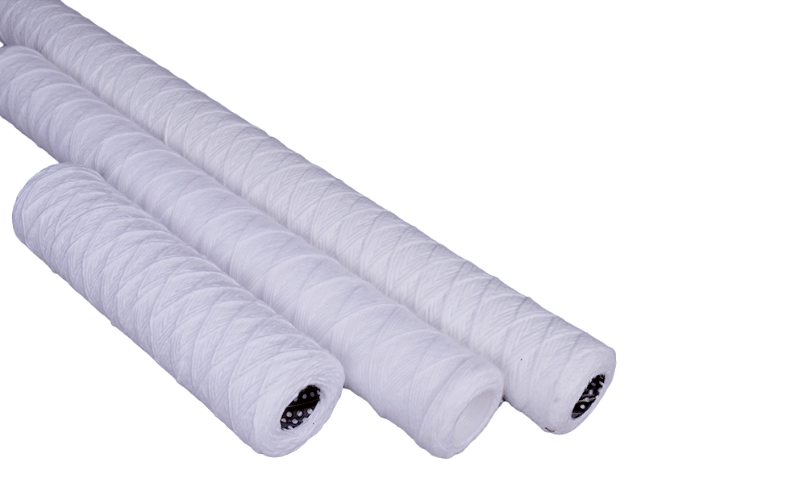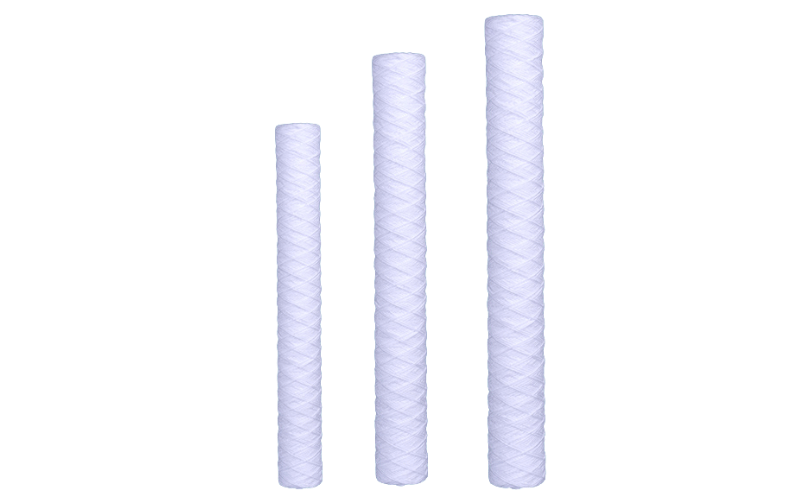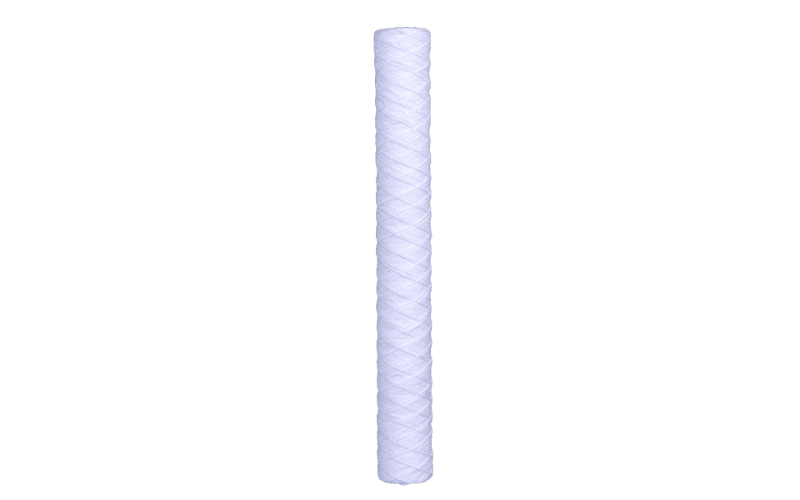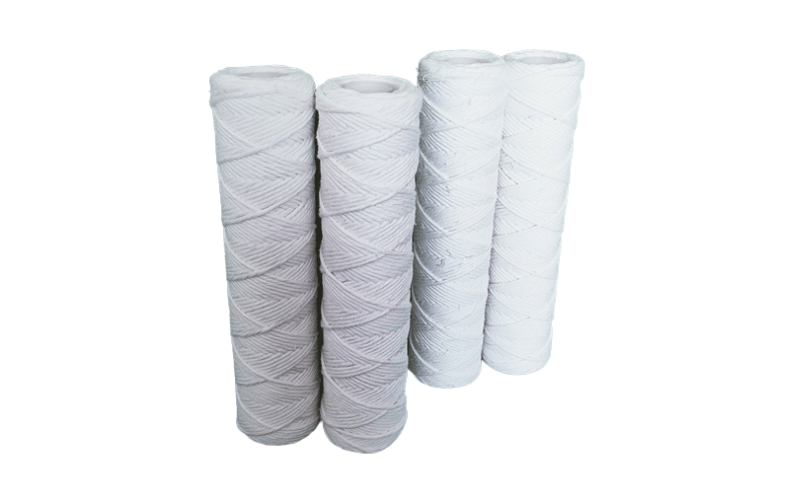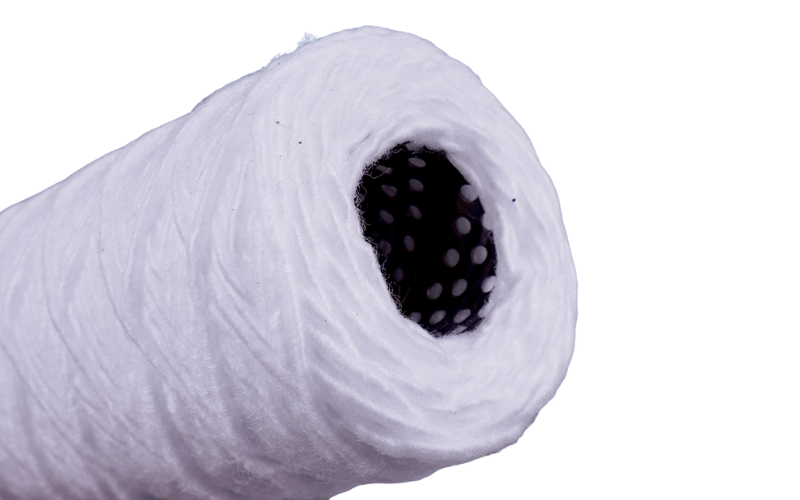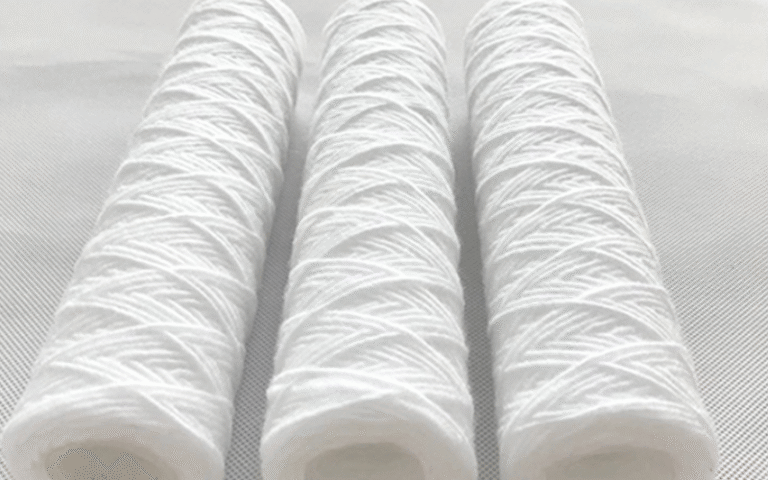String Wound Filter Cartridge
Home » Water Filter Cartridge » String Wound Filter Cartridge
Efficient Filtration | Long Service Life | Customizable Options
The String Wound Filter Cartridge is crafted by meticulously winding cotton threads around a stainless steel porous core. The winding process is controlled to adjust thread density and tension, enabling the production of filter elements with varying filtration precisions.
This cartridge is designed to remove suspended solids and particles from liquids effectively. Its high filtration pressure tolerance, gradient pore structure with larger outer and smaller inner pore sizes, and excellent deep filtration capabilities make it a versatile and efficient choice. It is compatible with various materials to meet the filtration needs of different liquids.
Advantages
- The central rod of the cotton filter cartridge is made of stainless steel, suitable for use with organic solvents, water, oil, alkaline solutions, beverages, and pharmaceuticals.
- Maximum operating temperature: 120°C
- Can withstand high filtration pressures.
- The filter cartridge has excellent compatibility.
- The filter pores have a dense inner structure and a porous outer structure, providing excellent deep filtration performance.
- Effectively removes suspended solids and particles from liquids, with low pressure drop and high dirt-holding capacity.
Technical Specifications
| Options | Parameter |
|---|---|
| Size&Spec | OD: ¢60/63mm |
| ID: ¢28/30mm | |
| Filtration Precision: 0.01- 100 Micron | |
| Material | Filter Media: PP, Absorbent Cotton, Glass Fiber |
| Center Rod: PP Or SS | |
| Operation Parameter | PH: 1-13 |
| Normal Working Temperature: | |
| PP: ≤ 80℃ | |
| Absorbent Cotton: ≤ 120℃ | |
| Glass Fiber: ≤ 180℃ | |
| Sterilization: Online 121+/- 2℃ , 30 Minutes Per Time. | |
| Liberation | Endotoxin: <0.5EU/Ml |
Applications of String Wound Filter Cartridge
- Microelectronics: Electroplating solutions, cleaning solutions, chemicals, solvents
- Water treatment industry: RO systems, seawater desalination, municipal water pre-filtration
- Food and beverage: Soft drinks, alcoholic beverages, edible oils, bottled water
- Petrochemicals: Oilfield water injection, fine chemicals, acid-base solvents
- Biopharmaceuticals: Eye drops, oral solutions, pharmaceutical agents, etc., pre-filtration
- Inks and coatings: Inks, inkjet printers, paints, coatings
How to Choose the Right String Wound Filter?
Selecting the right string-wound filter is essential for optimal filtration performance and system efficiency. Matching the filter specifications to your system’s operating conditions ensures effective sediment removal, equipment protection, and process integrity. Our range of string-wound filters is designed to meet the needs of industries like water treatment, food and beverage processing, and chemical production.
Key Factors to Consider
Micron Ratings
Micron rating determines the particle size a filter can capture. Our filters range from 1 micron (fine filtration) to 100 microns (coarse filtration).Matching Micron Rating to Application:
- 1–10 Microns (Fine Filtration): Ideal for high-purity processes like pharmaceutical production or beverage filtration, removing fine sediment and silt.
- 10–50 Microns (General Filtration): Suitable for industrial applications like water purification and pump protection.
- 50–100 Microns (Coarse Filtration): Best for pre-filtration or systems requiring basic particle removal, such as wastewater treatment.
Choosing the correct micron rating ensures efficient operation without overloading downstream filters.
Filter Media
The choice of filter media impacts chemical compatibility, temperature resistance, and durability.Popular Media Options:
- Polypropylene: Excellent chemical resistance, suitable for water, solvents, oils, and mild alkaline solutions. Withstands temperatures up to 120°C.
- Cotton: Ideal for filtering edible oils and beverages, where natural fibers are required.
- Glass Fiber: Handles higher temperatures, making it suitable for aggressive fluids or high-temperature applications.
- Stainless Steel (Core Material): Provides mechanical strength for high-pressure applications.
Select the media based on fluid characteristics, temperature, and durability needs.
10 Micron vs. 50 Micron Filters
The choice between 10-micron and 50-micron filters depends on your application’s filtration precision and contaminant type.
10 Micron Filter:
- Applications: Removes fine sediment, suitable for drinking water pre-filtration, food and beverage processing, and light industrial use.
- Benefits: Balances filtration efficiency and flow rate, capturing smaller particles with moderate resistance to flow.
50 Micron Filter:
- Applications: Designed for coarse filtration, such as pre-filtration in heavy industrial systems or removing visible debris.
- Benefits: Offers higher flow rates and minimal pressure drop, making it cost-effective for high-volume systems.
Choosing the Right Option:
- Use 10-micron filters for finer particulate removal.
- Opt for 50-micron filters in high-flow or heavy-contaminant environments.
Why Choose Our String-Wound Filters?
Our string-wound filters are available in multiple configurations to meet diverse industry needs. Whether you require fine filtration for sensitive processes or coarse filtration for pre-treatment, we provide tailored solutions to ensure system efficiency and reliability.
Need Help? Contact our team for expert guidance in selecting the perfect string-wound filter for your application.
Installation Guide for String Wound Filter Cartridges
Proper installation of string-wound filter cartridges is essential for optimal filtration performance and system efficiency. Follow this simple guide to ensure a smooth installation process and long-lasting results.
How to Install a 10 x 4.5 Inch Cartridge
Tools and Materials Needed:
- String-wound filter cartridge (10 x 4.5 inch)
- Filter housing wrench
- Clean cloth or towel
- Bucket or container (to collect residual water)
- Food-grade silicone grease (optional)
Step-by-Step Installation:
- Shut Off the Water Supply: Turn off the water supply to the filtration system.
- Release Pressure: Use the pressure release button (if available) to safely release residual pressure.
- Remove the Filter Housing: Place a bucket underneath and use a wrench to loosen and remove the housing.
- Dispose of the Old Cartridge: Remove the old filter and dispose of it properly.
- Clean the Housing: Wipe the inside of the housing to remove sediment or debris.
- Inspect and Lubricate O-Rings: Check the O-ring for damage and apply a thin layer of silicone grease for a proper seal.
- Install the New Cartridge: Place the string-wound cartridge into the housing, ensuring it is seated correctly on the central core.
- Reattach the Housing: Screw the housing back securely but avoid overtightening.
- Turn On the Water Supply: Slowly restore water flow and check for leaks.
- Flush the System: Run water through the system for several minutes to purge air and clean the new filter.
Your filter is now installed and ready for use!
Maintenance Tips for Long-Lasting Performance
To maximize the lifespan and efficiency of your string-wound filter cartridges, follow these maintenance tips:
- Monitor Pressure Drop: Check the system’s pressure gauge. A drop in pressure may indicate a clogged cartridge.
- Replace Regularly: Change the cartridge every 3 to 6 months or as recommended based on sediment load.
- Inspect for Leaks: Periodically check the housing and connections for leaks.
- Clean the Housing: Clean the housing during every cartridge replacement to prevent debris buildup.
- Store Spare Cartridges Properly: Keep replacements in a cool, dry place to maintain their quality.
- Flush New Cartridges: Always flush new cartridges to remove loose fibers or debris before use.
Common Mistakes to Avoid
Avoid these errors to ensure effective installation and filtration:
- Skipping Pressure Release: Always release system pressure before removing the housing to prevent water spray or damage.
- Neglecting O-Ring Maintenance: Reusing damaged O-rings or failing to lubricate them can cause leaks.
- Overtightening the Housing: Excessive tightening can crack the housing or make future replacements difficult.
- Incorrect Cartridge Placement: Ensure the cartridge is properly aligned with the core to avoid filtration issues.
- Failing to Flush the System: Not flushing the cartridge can introduce loose fibers or debris into the water.
By following these steps and avoiding common mistakes, you can ensure your string-wound filter cartridges deliver reliable and efficient performance. Need help? Contact our team for expert guidance!
Comparing String Wound Filters with Other Filter Types
Choosing the right filter type is essential for achieving optimal system performance. String-wound filters offer unique advantages, making them a reliable choice for a wide range of applications. Here’s how they compare to other popular filter types like depth filters, pleated cartridges, and sediment filters.
String Wound vs. Depth Filters
Key Differences in Design:
- String Wound Filters: Made by winding yarn or threads around a central core, creating a gradient density structure. This design captures both large and small particles across multiple layers.
- Depth Filters: Constructed as porous blocks or multi-layered media with a uniform design, offering consistent fine filtration.
Performance and Applications:
- String Wound Filters: Ideal for systems with fluctuating contaminant loads or where customizable micron ratings are needed.
- Depth Filters: Best for applications requiring consistent fine filtration without the need for customization.
When to Choose:
- Use string-wound filters for versatility and variable filtration needs.
- Opt for depth filters for consistent fine filtration in stable environments.
Advantages of String Wound Filters Over Pleated Filters
Why Choose String Wound Filters?
- Gradient Density Filtration: Larger pores on the outer layers and tighter pores inside provide exceptional dirt-holding capacity, perfect for high sediment levels.
- Withstands High Pressures: Durable construction ensures reliable performance under high differential pressures.
- Non-Clogging Design: Depth filtration reduces clogging, extending service life and reducing maintenance.
- Cost Efficiency: More economical for systems handling heavy particulate loads due to their longer lifespan.
When to Use Pleated Filters:
- Larger Surface Area: Pleated filters have a folded design, offering lower pressure drops and higher flow rates.
- Precision Filtration: Ideal for applications requiring consistent flow and fine filtration.
Choosing the Right Option:
- Use string-wound filters for heavy sediment loads and variable filtration needs.
- Opt for pleated filters for precision filtration and high flow rate requirements.
String Wound Filters vs. Sediment Filters
Key Differences in Use Cases:
Sediment Filters:
- Use Cases: Prefilters for removing larger debris like sand, rust, and dirt. Commonly used in household and light industrial systems.
- Advantages: Affordable, easy to install, and effective for coarse filtration.
String Wound Filters:
- Use Cases: Superior depth filtration for capturing both large and small particles. Ideal for industries like water treatment, food processing, and chemical production.
- Advantages: Greater dirt-holding capacity, versatility, and compatibility with various materials like polypropylene or cotton.
Choosing the Right Type:
- For coarse prefiltration (e.g., sediment or rust removal in household systems), choose sediment filters.
- For industrial or commercial systems with variable contaminant loads, choose string-wound filters for durability and performance.
Why Choose String Wound Filters?
String-wound filters stand out for their versatility, durability, and ability to handle variable filtration needs. Whether you’re dealing with high sediment levels or require robust filtration for industrial applications, string-wound filters provide reliable performance.
Need Help? Contact our team for expert guidance in selecting the best filtration solution for your system.
String Wound Filter Cartridge FAQs
Q: What is the lifespan of a string wound cartridge?
A: The lifespan of a string wound cartridge depends on water quality and sediment levels. Under typical conditions, they last between 6 to 12 months. Replace them earlier if you notice a significant drop in water pressure or quality.
Q: Are string wound filters suitable for all water types?
A: String wound filters are versatile and compatible with various water types, including potable water, process water, and certain industrial fluids. However, ensure the material is suitable for specific chemical or temperature requirements.
Q: What is a string wound water filter?
A: A string wound water filter is a cartridge made by tightly winding polypropylene or similar materials around a core. It effectively removes sediment and particulates from water, making it suitable for residential, commercial, and industrial applications.
Q: What does the micron rating indicate in string wound filters?
A: The micron rating defines the particle size a filter can capture. For example, a 5 micron filter removes particles as small as 5 microns. Lower ratings indicate finer filtration, enhancing water quality.
Q: Can a 20 micron string wound filter effectively reduce sediment from water?
A: Yes, a 20 micron string wound filter is effective for removing larger sediment particles. For finer filtration, choose a lower micron rating, such as 5 or 10 microns.
Q: What is the difference between a big blue filter and standard string wound filters?
A: Big blue filters are larger, typically 4.5 inches in diameter, and designed for high-flow applications. Standard string wound filters are smaller, around 2.5 inches in diameter, and commonly used in residential systems with lower flow requirements.
Q: Are string wound filters suitable for use with reverse osmosis systems?
A: Yes, string wound filters work well as pre-filters in reverse osmosis systems. They trap sediment and larger particles, protecting the sensitive reverse osmosis membrane and prolonging its lifespan.
Q: What is the significance of the surface area in string wound filters?
A: A larger surface area in string wound filters allows for more effective sediment capture while maintaining higher flow rates. This improves filtration efficiency and extends the cartridge's operational life.
Q: How often should I replace my string wound filter cartridges?
A: String wound filter cartridges should generally be replaced every 6 to 12 months or sooner if a drop in water pressure or quality occurs. Consider water conditions and system usage for precise intervals.


